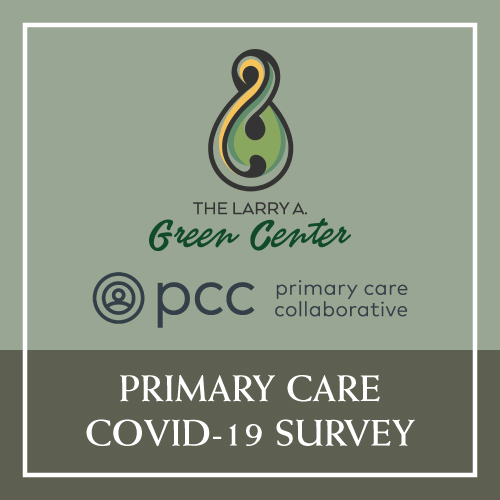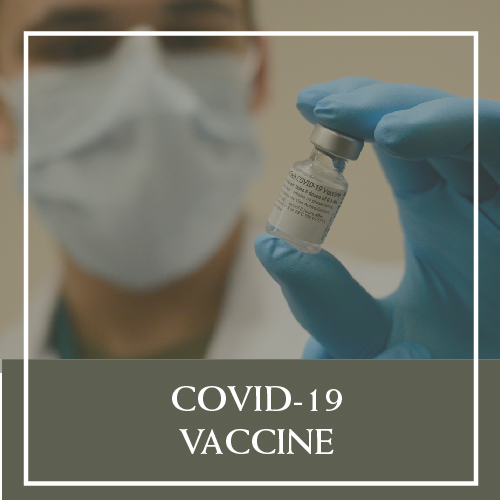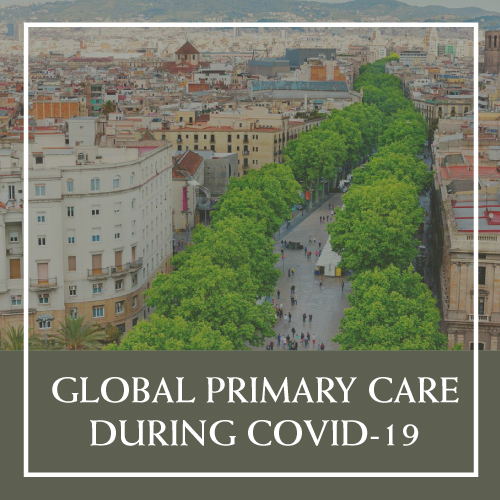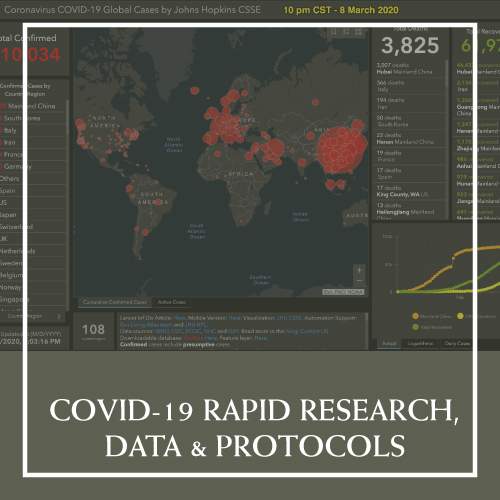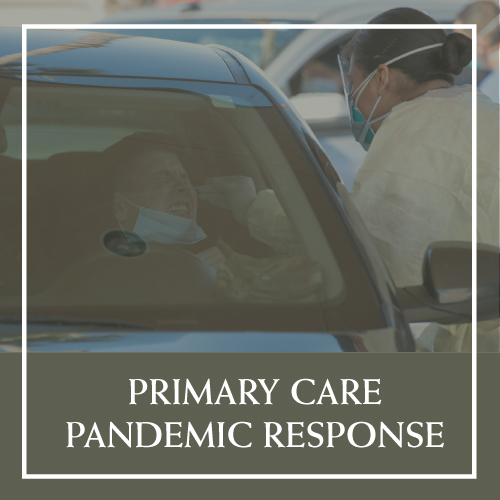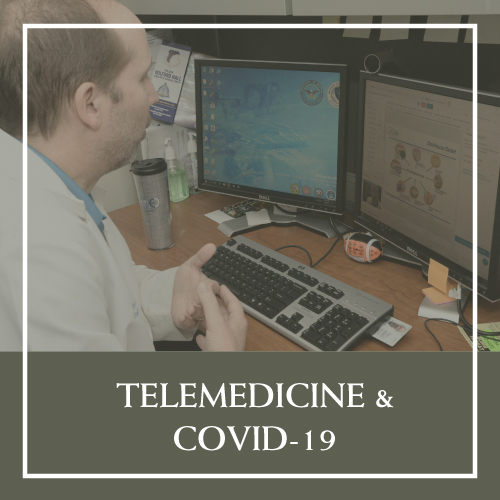 An index of open-access COVID-19-related preprint content relevant to primary care published 2020-2022. For push notifications when new content is added to this collection, please follow @AnnFamMed on Twitter.
An index of open-access COVID-19-related preprint content relevant to primary care published 2020-2022. For push notifications when new content is added to this collection, please follow @AnnFamMed on Twitter.
Browse by Author
Browse by Topic
Latest Works
Special Report: Quick COVID-19 Primary Care Weekly Survey, Series 35
Rebecca Etz, Advisory Group, Larry A. Green Center
More than half of surveyed clinicians say primary care is crumbling. They paint both a stark and an inspiring picture of primary care as the second year of the COVID-19 pandemic comes to a close. Over 40% of respondents report they are mentally and financially fragile, a level that has persisted over the past 24 months. Fewer than a quarter of practices report they are fully staffed. One third of clinicians report currently denied and/or seriously overdue payments from insurers and health plans – this on top of previously reported and unaddressed financial losses. And while fee-for-service is dominant within most payment models for primary care, only 21% of clinicians find this form of payment sufficient. Simultaneous with these obstacles, clinicians also report increased volunteerism, new services to lessen burden on the health system, and expanded levels of practice-provided assistance to address patients’ social vulnerabilities. Series 35 summary. 21 March, 2022. Nonrefereed, online collection only. Permanent URL: https://hdl.handle.net/2027.42/171922
Special Report: Quick COVID-19 Primary Care Weekly Survey, Series 34
Rebecca Etz, Advisory Group, Larry A. Green Center
The stresses and adaptive responses of primary care have remained consistent over the last 12-month period. Questions repeated from surveys fielded November 2020 and April 2021 show a primary care workforce that has continued to expand services for patients, establish meaningful community partnerships, and increase volunteerism, despite lack of systemic relief from pandemic-induced hardships. However, primary care is overstretched. That only 6 in 10 clinicians report having conducted well child visits and having kept pace with routine childhood immunizations is cause for concern. Just over half of respondents (51%) reported accepting new patients from now closed practices. Series 34 summary. 21 March, 2022. Nonrefereed, online collection only. Permanent URL: https://hdl.handle.net/2027.42/171921
Special Report: Quick COVID-19 Primary Care Weekly Survey, Series 33
Rebecca Etz, Advisory Group, Larry A. Green Center
Notable loss of primary care workforce since the start of the pandemic is evidenced in this latest survey of front-line workers. A large portion of respondents report inability to fill both clinician and staffing positions, in addition to direct knowledge of closed practices and an influx of new patients seeking care after their practice has closed. Staffing ratios have shifted causing 3 in 10 clinicians to report they have fewer people involved in direct patient care in their practice. The majority have found telehealth useful for increasing access to care and meeting the needs of patients, however low reimbursements for this mode of care delivery remain troublesome. Six in ten report mental stress/exhaustion is at an all-time high in their practice. Noted by 67% of respondents: we (primary care workforce) are clinically fragile – when is someone going to notice! Series 33 summary. 21 March, 2022. Nonrefereed, online collection only. Permanent URL: https://hdl.handle.net/2027.42/171920
Special Report: Quick COVID-19 Primary Care Weekly Survey, Series 32
Rebecca Etz, Advisory Group, Larry A. Green Center
Primary care clinicians continue to share evidence of acute distress in our health care system with over half of respondents noting severe/near severe strain in their practice. A new COVID-19 surge has begun at a time when 62% of clinicians report burnout and mental exhaustion in their practice is at an all-time high. One in ten say they receive weekly calls from health care colleagues in the midst of a personal mental health crisis. Many (43%) cite record high wait times for new patients and preventive care visits as primary care must also now adapt to health needs generated by severely delayed access to specialty care. While access to COVID-19 vaccine has improved, rising mental health concerns in the general population and an increase in acute conditions has compromised preventive care and chronic disease management. Series 32 summary. 21 March, 2022. Nonrefereed, online collection only. Permanent URL: https://hdl.handle.net/2027.42/171919
Innovation: Long COVID Shared Medical Appointments: Lifestyle and Mind-Body Medicine with Peer Support
Yufang Lin, Robert Saper, Sonal J. Patil
Long COVID is a new rising health concern with no clear treatment guidelines. Patients have multiple distressing symptoms which are difficult to address in time-restricted clinic visits. Early evidence indicates a role of cytokines and chronic inflammatory processes in developing long COVID. Healthy lifestyle behaviors and modifying stress responses reduce chronic systemic inflammation. We created a novel shared medical appointment (SMA) program to provide healthy lifestyle education, mindfulness training, and group peer support for patients with long COVID symptoms. 20 Jan, 2022. Non-refereed, under review. Permanent URL: https://hdl.handle.net/2027.42/171444
Published in Annals - Telehealth/Telemedicine
Innovative Family Medicine and Behavioral Health Co-Precepting via Telemedicine
Alexander Kowalski, et al
The onset of the COVID-19 pandemic created an opportunity to find a way to maintain a family medicine(FM)/behavioral health co-preceptorship model when treating patients and educating resident physicians via telehealth. The ability to identify and treat mental health disorders is a core skill for FM residents to acquire during training, therefore it was imperative to continue to find a way to provide this resource to residents and patients.
STFM Forms Task Force to Develop a National Telemedicine Curriculum
From the Society of Teachers of Family Medicine (STFM)
Telepsychiatric Consultation as a Training and Workforce Development Strategy for Rural Primary Care
Morhaf Al Achkar, et al
Weekly systematic case reviews using telepsychiatric consultation served both as a model for patient care and as a training and workforce development strategy in rural primary care sites delivering collaborative care. These are important benefits to consider in implementing the collaborative care model of behavioral health integration.
Physical Distancing With Social Connectedness
David Bergman, et al
The current COVID-19 pandemic is full of opportunity to use remote communication to develop healing human relationships. What we need in a pandemic is not social distancing, but physical distancing with social connectedness.
Patients Assess an eConsult Model's Acceptability at 5 US Academic Medical Centers
Sara L. Ackerman, et al
In, But Out of Touch
Martina Ann Kelly and Gerard J. Gormley
Initial Implementation of a Web-Based Consultation Process for Patients With Chronic Kidney Disease
Nynke D. Scherpbier-de Haan et al
Department of Primary and Community Care, Radboud University Nijmegen Medical Centre, Nijmegen, The Netherlands.
A Web-based consultation system between family physicians and nephrologists reduces the number of referrals and appears to improve treatment appropriateness among patients with chronic kidney disease. The authors assert these findings support the introduction of telenephrology in primary care as a means of delivering higher quality, more convenient care at a lower cost. They conclude that on a broader scale, e-consultation has the potential to break down walls between primary and specialty care.
Connecting People With Multimorbidity to Interprofessional Teams Using Telemedicine
Jocelyn Charles, et al,
Department of Family and Community Medicine, University of Toronto, Toronto, Ontario, Canada.
This study assessed the feasibility, cost, and satisfaction of a synchronistic telemedicine model that connected patients with multimorbidities with a primary care team that included primary care physician, telemedicine-trained nurses, specialists from psychiatry and internal medicine, as well as a social worker, pharmacist, home care and community coordinator, and other professionals as appropriate, based on the patient’s needs. All 74 patient survey respondents indicated the intervention improved their access to interdisciplinary resources, and 97% reported feeling hopeful their conditions would improve as a result. Of 21 PCP survey respondents, 100% reported they would use the model intervention again, and 90% reported improved confidence in managing their patient’s care.
Patient Perceptions of Telehealth Primary Care Video Visits
Kristin L. Rising, et al,
Department of Emergency Medicine, Sidney Kimmel Medical College at Thomas Jefferson University.
This qualitative study of 19 adult patients interviewed after video visits with their primary care clinician found that patients accept and even prefer video visits to in-person office visits. Participants reported feeling comfortable talking with their clinicians over a video call, and they identified convenience and decreased costs as benefits. Primary concerns with video visits concerned privacy, including potential for work colleagues to overhear conversations, and questioning the ability of the clinician to perform an adequate physical examination.
Expanding Primary Care Access: A Telehealth Success Story
M.R. Gonçalves, RN,
Universidade Federal do Rio Grande do Sul (UFRGS) School of Medicine, Porto Alegre, Brazil.
The authors describe a telemedicine project in Brazil that included the development of a teleconsulting hotline, increased efficiencies in referral protocolas, and telediagnosis services. They briefly discuss the program's impact on increasing access to specialist consultations, diagnostic testing, and specialized medical advice to physicians.
Family Medicine COVID-19 Front Lines Blog
(Last updated Apr 2022)
Please check out our blog for family medicine case notes from the COVID-19 front lines. This is a non-refereed extension of the COVID-19 online collection. Submit your case notes and on-the-ground primary care experiences to our covidcasenotes@umich.edu team.
Published in External Sources
Editorial: An All-Hazards Approach to Pandemic COVID-19: Clarifying Pathogen Transmission Pathways Toward the Public Health Response (Journal of Environmental Health, published May, 2020) by Christopher Eddy, MPH, REHS, CP-FS, Richard Schuster, MMM, MD, FACP, FRCP (Edin), Eriko Sase, PhD
Covid-19: A Remote Assessment in Primary Care (BMJ published online 25 March 2020) - Trisha Greenhalgh, Gerald Choon Huat Koh, Josip Car
Essay: I’m a Family Doctor Fighting Against Fear and Struggling With Distancing While Trying to Keep my Patients Healthy - (The Conversation published 25 March 2020), Tammy Chang, MD, MPH, MS, family physician
COVID-19 Literature Digital Library compiled by Sachin Shah, MD, MPH UCSF @sachinjshah
Essay: Covid-19: Don’t Forget the Impact on US Family Physicians - (BMJ published 26 March 2020), Douglas Kamerow, Robert Graham Center
Editorial: Covid-19 is Harshly Testing our Capacities as Physicians and Medical Staffers - (Washington Post published 28 Marhc 2020), Ishani Ganguli, MD, MPH @IshaniG
Essay: Medicine: Before COVID-19, and After - (The Lancet published 31 March 2020), Margaret McCartney, General Practioner, @mgtmccartney
Letter: Postacute Care Preparedness for COVID-19: Thinking Ahead - (JAMA published 25 March 2020), David C. Grabowski, PhD and Karen E. Joynt Maddox, MD, MPH
Guidance for Outpatient Management of COVID-19 - (Live Google document), Jill Fenske MD, Jenna B. Greenberg MD, Elizabeth K. Jones MD, Nell Burger Kirst MD, Feranmi Okanlami MD, MS, Daniel S. Oram MD, Jacob Wasag MD, University of Michigan Medical School Department of Family Medicine
Discussion: In the comments: A 20 March 2020 JAMA editorial calls on readers to share their "creative immediate solutions for how to maximize the use of PPE, to conserve the supply of PPE, and to identify new sources of PPE."
Additional Resources
Centers for Disease Control and Prevention (CDC) - Coronavirus (COVID-19)
National Institutes of Health (NIH) - Coronavirus (COVID-19) Resources and Updates
World Health Organization (WHO) - Coronavirus disease (COVID-19) Pandemic
American Academy of Family Physicians (AAFP) - COVID-19: The Latest Updates
Society of Teachers of Family Medicine (STFM) - Medical Education During the COVID-19 Pandemic
American Medical Association (AMA) - COVID-19 (2019 Novel Coronavirus) Resource Center for Physicians
The Hastings Center - Ethics Resources on the Coronavirus (Covid-19)
COVID-19 Health Literacy Project - Downloadable factsheets in 30 languages, developed by Harvard Medical School students, vetted by faculty clinicians, in collaboration with Harvard Health Publishing
Last updated 22 Mar, 2022 10:55 EST


